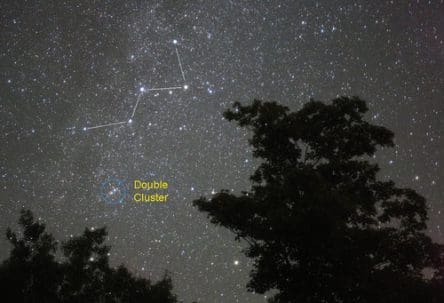November Feature – The Double Cluster in Perseus

Open star clusters are groups of a few hundred to a few thousand stars, all having formed at about the same time from the same vast, cold cloud of molecular hydrogen. For the backyard astronomer, open clusters are favorite binocular and small telescope targets as they can provide stunning vistas of distant, glittering suns all loosely bound to one another by their mutual gravity. Every autumn, two of the most popular of open clusters becomes well placed upon our evening sky for easy viewing: The Double Cluster in the constellation of Perseus.
WHEN AND WHERE TO LOOK

Step outside on a November evening, face north and look up to locate the distinctive W-shape of five stars that form the constellation of Cassiopeia. Locate the stars Navi and Ruchbah within Cassiopeia. Now, draw an imaginary line in between these two stars and continue to extend the line roughly twice the Navi-Ruchbah distance and you should then be near the Double Cluster within the borders of the constellation of Perseus. Under dark sky conditions (well away from city lights) the double cluster should show up as a faint smudge of light upon the sky.

Binoculars and small aperture telescopes (2” to 4”) will show these two star clusters at their best. With binoculars, this seemingly starless patch of sky suddenly blossoms into a profusion of white and blue-white stars, glittering like diamonds in the darkness of space.
If you use a small telescope then be sure to select a low power eyepiece for your observations for the best views. As with the binoculars, you should see large numbers of white and blue-white stars but you should also be able to count a few yellow and orange colored stars among them as well.
WHAT YOU ARE SEEING
As the name implies, the Double Cluster, or NGC 869 and NGC 884, is in fact two distinct open star clusters. They are approximately 7,600 light years from Earth and are separated from each other by just a few hundred light years. They are also fairly young with an estimated age of about 12.8 million years. By comparison, the familiar Pleaides cluster, is about 100 million years of age and are some 400 light years distant. If the Double Cluster were as close to Earth as the Pleaides, they would light up our night sky with some of the brightest stars visible to us.

Astronomers use a system for classifying stars that is based upon their surface temperatures (a system worked out during the early 20th century at Harvard University by Annie Jump Cannon, a distant relative of former UALR professor Dr. Grant Cooper). The system uses the letters O, B, A, F, G, K, and M with the letter O representing the hottest stars and the letter M the coolest.
Each cluster within the Double Cluster contains several hundred-hot blue white supergiant stars designated as types O, A, and B. Some of these stars are incredibly bright, shining with a luminosity that is 50,000 times that of our own Sun.
Cooler red supergiant stars can be seen in NGC 884 (the easternmost cluster) but appear to be absent within NGC 869. These red stars are more highly evolved than the bluer stars and are approaching the ends of their lives.

Astronomers have determined that the Double Cluster is moving through space in our direction at the rate of 80,000 kilometers per hour. In the time it took you to read this article the clusters will have collectively moved closer to you by some 1200 km. But don’t get too excited, I’m afraid that you and I will be long gone before we would ever be able to notice the difference.
